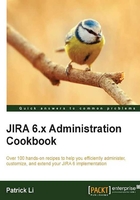
What this book covers
Chapter 1, JIRA Server Administration, contains recipes that will help you to administer your JIRA server, including installing, upgrading, and securing JIRA with SSL certificates.
Chapter 2, Fields and Screens, contains recipes that let you customize JIRA with custom fields and screens. This chapter also includes advanced techniques such as using scripts and add-ons to add more control to fields that are not available with JIRA.
Chapter 3, JIRA Workflows, covers one of the most powerful features in JIRA, with recipes that show you how to work with workflows, including permissions and user input validation. This chapter also covers workflow bundling and using scripts to extend out-of-the-box components.
Chapter 4, User Management, explains how users and groups are managed within JIRA. It starts with simple recipes to cover out-of-the-box user management features, and goes on to include topics such as LDAP integration and various single sign-on implementations.
Chapter 5, JIRA Security, focuses on the different security control features offered by JIRA, including different levels of permission and authorization control. This chapter also covers other security-related topics, such as the user password policy and capturing electronic signatures.
Chapter 6, E-mails and Notifications, explains JIRA's e-mail handling system for both outgoing and incoming e-mails. This chapter also covers JIRA's event system and how to extend the basic set of events and templates.
Chapter 7, Integrating with JIRA, covers how to integrate JIRA with other systems, including other Atlassian applications and many other popular cloud platforms, such as Google Drive and GitHub.
Chapter 8, JIRA Administration, covers a broad range of recipes that help to make administrative tasks easier and simpler. It includes problem troubleshooting, task automation, and general scripting.
Chapter 9, JIRA Customizations, covers other user JIRA customization recipes to improve overall usability such as content translation, project cloning, and configuration migration.